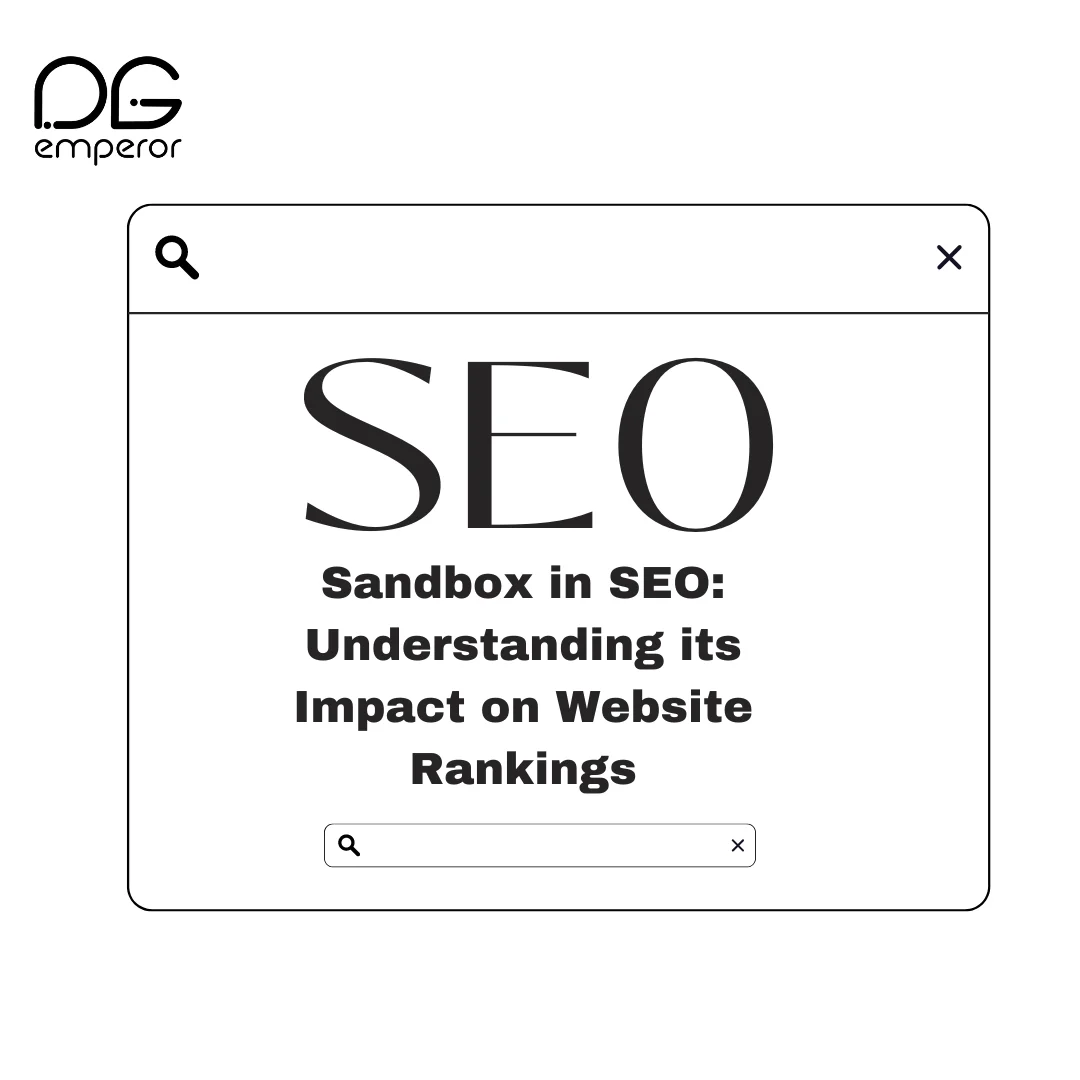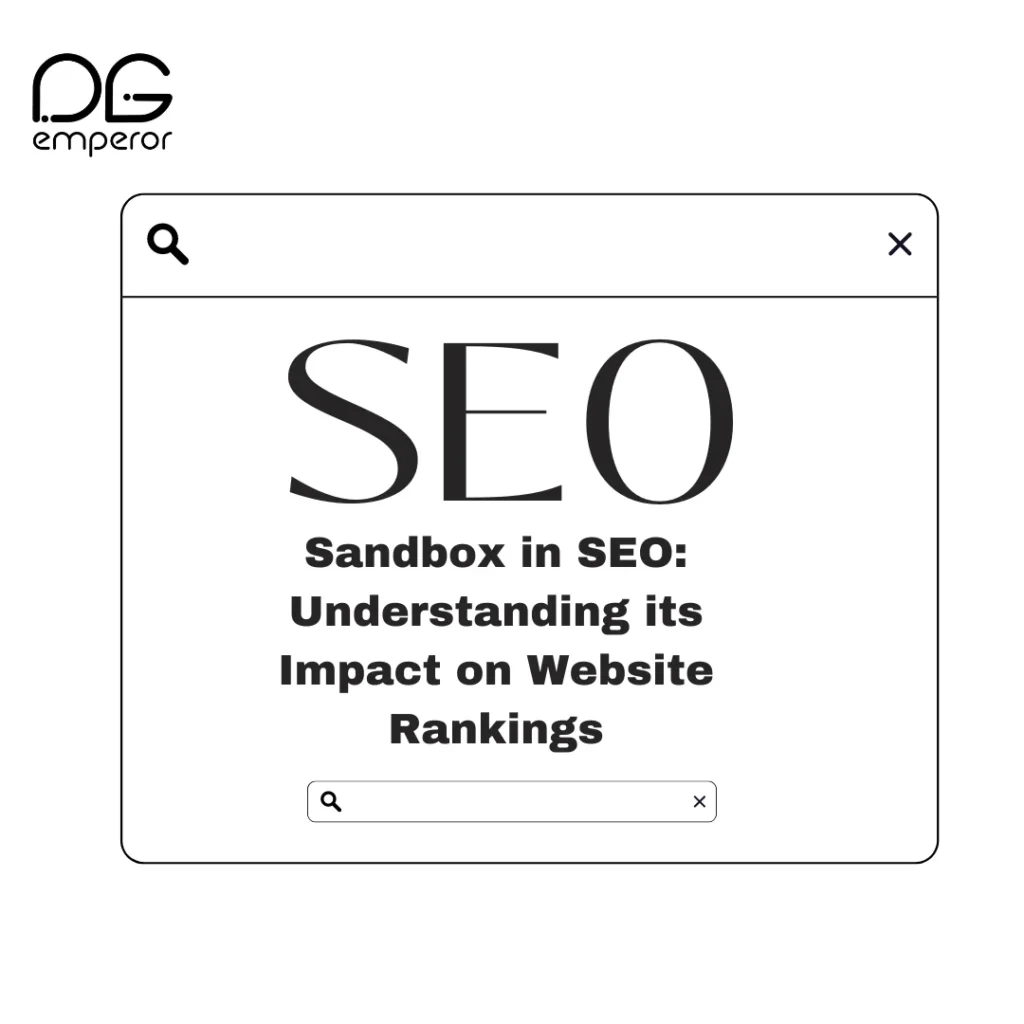Introduction of SEO
In the world of search engine optimization (SEO), numerous concepts and phenomena must be navigated to ensure websites rank well on search engines like Google. One such concept is the Google Sandbox, a somewhat elusive and often misunderstood phenomenon that can significantly impact a website’s rankings, particularly those that are newly launched. This blog, brought to you by Digi Emperor, aims to demystify the Sandbox effect, explore its causes and implications, and provide actionable strategies for mitigating its impact.
Understanding the Sandbox effect is crucial for anyone involved in SEO, from seasoned professionals to business website just starting their online reputation management journey. By grasping this concept, one can better strategize their SEO efforts, avoid common pitfalls, and expedite the process of achieving desirable rankings on search engine results pages (SERPs). In this blog, we will delve deep into the intricacies of the Google Sandbox, examining its causes, impact on website rankings, and effective ways to navigate and overcome this challenge.
What is the Google Sandbox?
Defining the Sandbox
The Google Sandbox refers to a hypothetical filter or probation period that prevents new websites from ranking well in Google’s search results, despite employing proper seo plans techniques. This concept first emerged around 2004 when webmasters and SEO professionals noticed that new sites, regardless of their quality or relevance, struggled to achieve high rankings on Google. Although Google has never officially confirmed the existence of the Sandbox, many in the seo campaigns believe it is a mechanism to filter out potential spam and ensure only credible and high-quality sites rise to the top.
The idea behind the Sandbox is to give new websites a probationary period during which their quality, relevance, and overall credibility are evaluated before they are allowed to rank competitively. This period can last from a few weeks to several months, depending on various factors such as the niche, competition, and the overall monthly seo efforts applied to the site. During this time, new websites may find it challenging to rank for their target keywords, even if they follow the best seo content practices.
Indicators of Sandbox Effect
Identifying whether a website is in the Sandbox can be challenging, as its symptoms can overlap with other SEO issues. However, common indicators include:
Sudden Drop in Rankings: A new website may experience a sudden drop in rankings despite consistent SEO efforts. This can be frustrating for site owners who have invested time and resources into optimizing their site.
Stagnation in Traffic Growth: Despite significant on-page and off-page optimization, the site may not see a substantial increase in organic seo. This stagnation can be a sign that the site is still under the Sandbox filter.
Difficulty ranking factors for Competitive Keywords: The website might rank for less competitive, long-tail keywords but struggle to make headway with more competitive ones. This indicates that while the site is recognized, it has not yet earned enough credibility to compete for high-traffic terms.
For instance, a new e-commerce site might rank for niche product terms but not for broader, high-traffic keywords. Real-life examples and case studies can provide further insights into these patterns. For example, a case study of a new travel blog post might show initial struggles to rank for high-traffic terms like “best travel destinations” but slowly gain traction with more specific keywords like “hidden gems in Southeast Asia.”
Causes of the Sandbox Effect
New Domain Phenomenon
New domains are particularly susceptible to the Sandbox effect. Google tends to scrutinize new sites more rigorously to prevent spammy or low-quality sites from manipulating search results. This “probation period” allows Google to evaluate the site’s credibility, content quality, and user engagement before it earns a place in higher search rankings. The reasoning behind this is that older, established domains have had more time to build a reputation and demonstrate their value, whereas new domains need to prove themselves.
Algorithmic Factors
Google’s complex algorithms play a significant role in the Sandbox effect. Key algorithms like Panda (focused on content quality) and Penguin (targeting link spam) can influence whether a site experiences the Sandbox. These algorithms are designed to reward high-quality, user-friendly sites while penalizing those who attempt to game the system with quality content optimization or unnatural backlink profiles.
Google’s RankBrain, an AI-based component of its search algorithm, also plays a role in evaluating new sites. RankBrain looks at user experience metrics, such as click-through rates and time spent on the site, to determine the relevancy and quality of a website. New sites need to perform well in these areas to avoid being sandboxed.
Content and Quality Issues
Content quality is paramount in avoiding the Sandbox. New websites with thin, duplicated, or low-value content are more likely to be affected. Google’s algorithms prioritize sites that offer unique, informative, and engaging content. Therefore, investing in high-quality content creation from the outset is essential to mitigating the Sandbox effect.
For example, a new health and wellness blog should focus on providing well-researched, original articles that address common health concerns, offer practical advice, and engage readers through interactive elements like videos and infographics. This not only helps in avoiding the Sandbox but also builds a loyal readership and enhances the site’s authority over time.
Impact on Website Rankings

Short-Term vs. Long-Term Impact
The Sandbox effect can have both short-term and long-term impacts on a website’s SEO performance. In the short term, new sites may struggle to gain visibility and traffic, which can be discouraging for businesses hoping for quick results. However, with persistent SEO efforts and adherence to best practices, the long-term impact can be minimized, leading to eventual recovery and sustained rankings.
Short-term impacts include limited visibility in SERPs and lower organic traffic. However, the long-term benefits of emerging from the Sandbox include improved trustworthiness in the eyes of Google, which can result in more stable and higher rankings over time.
Case Studies
Examining case studies of websites that experienced the Sandbox effect can provide valuable insights into how to navigate this challenge. For example, a new blog that initially struggled to rank but eventually gained traction through consistent content updates and strategic link-building efforts illustrates the importance of perseverance and strategy in overcoming the Sandbox.
Case Study 1: Tech Startup Blog
A tech startup launched a blog with in-depth articles on emerging technologies. Initially, despite high-quality content, the blog struggled to rank. By consistently publishing new articles, engaging with the tech community on social media, and earning backlinks from reputable tech sites, the blog eventually saw a steady increase in traffic and rankings. This case study highlights the importance of building a strong content foundation and service providers leveraging social proof and backlinks to gain authority.
Case Study 2: Online Fashion Retailer
An online fashion retailer launched a new website and focused on creating unique, engaging content like fashion guides, trend reports, and customer stories. Initially, the site experienced limited traffic growth, but through continuous SEO efforts, including optimizing product pages and building backlinks, the site gradually overcame the Sandbox effect and achieved significant improvements in rankings and sales. This case demonstrates the effectiveness of combining high-quality content content writing with strategic SEO practices to build credibility and authority.
Comparisons with Established Websites
Established websites generally have stronger domain authority and a more extensive backlink profile, which helps them maintain higher rankings. In contrast, new sites must build these elements from scratch. Understanding these differences can help new website owners set realistic expectations and focus on long-term growth strategies.
For example, an established news website with a decade-long presence will naturally rank higher for news-related queries than a newly launched news blog. The new blog must focus on building authority through consistent, high-quality content, gaining backlinks from reputable sources, and engaging with its audience on social media.
How to Mitigate the Sandbox Effect
Best Practices for New Websites
When launching a new website, adhering to seo ranking best practices is crucial. This includes conducting thorough keyword research, optimizing on-page elements, and ensuring the site is technically sound. Additionally, creating a robust content plan and establishing a social media presence can help drive initial traffic and signals to Google that the site is valuable and relevant.
Keyword Research: Identify relevant keywords with a mix of high and low competition. Use tools like Google Keyword Planner, SEMrush, or Ahrefs to find the best keywords for your niche.
On-Page Optimization: Ensure that your website’s title tags, meta descriptions, headers, and content are optimized for your target keywords.
Technical SEO: Make sure your site is mobile-friendly, has a fast loading speed, and is free seo of technical issues that could hinder its performance in search results.
Content Plan: Develop a content calendar that outlines your publishing schedule and the topics you will cover. Consistency is key to keeping your audience engaged and signaling to Google that your site is active.
Content Strategies
High-quality, engaging content is the cornerstone of any successful SEO strategy. New websites should focus on creating content that addresses their target audience’s needs and interests. Regular updates and maintaining content freshness can also signal to Google that the site is active and continually providing value to users.
High-Quality Content: Produce well-researched, informative, and engaging content. Use a mix of text, images, videos, and infographics to cater to different audience preferences.
Regular Updates: Consistently update your content to reflect new information, trends, or user feedback. This shows Google that your site is relevant and up-to-date.
Engagement: Encourage user engagement through comments, social shares, and interactive elements. Engaged users are more likely to spend time on your site, which can positively impact your rankings.
Building Authority
Building domain authority quickly involves acquiring high-quality backlinks from reputable sources. Guest blogging, outreach to industry influencers, and creating shareable content can help attract these valuable links. Social proof, such as positive reviews and mentions on social media, also contributes to building authority.
Backlink Building: Focus on earning backlinks from high-authority websites in your niche. This can be achieved through guest blogging, partnerships, and creating link-worthy content.
Social Proof: Encourage satisfied customers to leave positive reviews and share their experiences on social media. Social signals can indirectly impact your SEO by driving traffic and increasing engagement.
Industry Engagement: Participate in industry forums, webinars, and conferences. Building relationships with influencers and thought leaders can lead generation to valuable backlinks and increased visibility.
Technical SEO and User Experience
Ensuring your website is technically sound and provides a great user experience is critical for avoiding the Sandbox effect. Technical seo agencies include optimizing site speed, and mobile-friendliness, and ensuring a clean site architecture.
Site Speed: A fast-loading site enhances user experience and reduces bounce rates. Use tools like Google PageSpeed Insights to identify and fix issues that may be slowing down your site.
Mobile Optimization: Ensure your site is fully responsive and provides a seamless experience across all devices. With mobile-first indexing, Google prioritizes mobile-friendly sites.
Clean Site Architecture: A well-structured site makes it easier for search engines to crawl and index your content. Use clear and logical URL structures, and ensure all pages are easily accessible.
Recovery from the Sandbox
Identifying Sandbox Exit
Recognizing when a website is exiting the Sandbox is essential for adjusting SEO strategies accordingly. Signs of exiting the Sandbox include gradual improvements in rankings and increased organic traffic. Monitoring these changes can help website owners identify the right time to ramp up their SEO efforts.
Ranking Improvements: Monitor your keyword rankings regularly. Gradual improvements indicate that your site is gaining authority and moving out of the Sandbox.
Traffic Growth: An increase in organic traffic, especially from competitive keywords, is a strong sign that your site is emerging from the Sandbox.
Engagement Metrics: Improved user engagement metrics, such as longer session durations and lower bounce rates, can also indicate that your site is gaining traction.
Continuous Improvement
Even after exiting the Sandbox, continuous improvement is necessary to maintain and enhance rankings. This involves staying updated with Google’s algorithm changes, regularly publishing high-quality content, and consistently building backlinks. Ongoing monitoring and adaptation to new seo tips trends and best practices are key to sustained success.
Algorithm Updates: Stay informed about Google’s algorithm updates and adjust your SEO strategies accordingly. Follow reputable SEO blogs and forums for the latest news and insights.
Content Quality: Maintain a high standard for your content. Regularly audit your site for outdated or underperforming content and update or remove it as needed.
Backlink Profile: Continuously seek opportunities to earn high-quality backlinks. Monitor your backlink profile for any toxic links and disavow them to maintain a healthy link profile.
Tools and Resources
Various SEO tools can help track and analyze the Sandbox effect, such as Google Analytics, Google Search Console, and third-party SEO software like SEMrush and Ahrefs. These tools provide valuable insights into website performance, keyword rankings, and backlink profiles, enabling website owners to make data-driven decisions.
Google Analytics: Track your website’s traffic, user behavior, and conversion metrics. Use this data to identify trends and areas for improvement.
Google Search Console: Monitor your site’s performance in search results, track keyword rankings, and identify any technical issues that need addressing.
Third-Party SEO Tools: Tools like SEMrush, Ahrefs, and Moz provide comprehensive SEO analysis, including keyword research, backlink tracking, and competitor analysis. Use these tools to gain a competitive edge and refine your SEO strategies.
Advanced Recovery Techniques
For those who have been sandboxed for an extended period, advanced recovery techniques may be necessary. These strategies require a more in-depth approach to SEO and often involve a combination of technical, on-page, and off-page tactics.
Deep Site Audits: Conduct thorough site audits using tools like Screaming Frog, SEMrush, or Ahrefs. Identify any technical issues, broken links, duplicate content, or crawl errors that could be hindering your site’s performance.
Content Revamp: Refresh and revamp existing content. Ensure that every piece of content on your site is unique, valuable, and well-optimized for both users and search engines. Remove or update outdated content.
Link-Building Campaigns: Launch aggressive link-building campaigns to acquire high-quality backlinks. Focus on white-hat techniques such as guest blogging, earning editorial links, raising brand awareness, and leveraging partnerships.
User Experience Improvements: Enhance user experience (UX) on your site. Improve site navigation, reduce load times, and ensure that your site is accessible and easy to use on all devices.
Schema Markup: Implement schema markup to help search engines better understand your content. This can enhance your site’s appearance in search results and improve click-through rates.
The Future of the Sandbox Effect
As Google continues to evolve its algorithms, the Sandbox effect may also change seo project professionals must stay ahead of these changes to effectively manage new websites and their rankings. Understanding future trends and preparing for them can help mitigate the impact of the Sandbox.
AI and Machine Learning
Google’s increasing use of AI and machine learning, particularly with RankBrain and BERT, means that the criteria for evaluating new websites will ecommerce seo services offer more sophisticated in the e-commerce business. These technologies help google seo understand the context and intent behind user queries, which means that websites need to focus on providing relevant, high-quality content that meets user needs.
Content Relevance: Ensure that your content is highly relevant to your target audience. Use natural language and focus on answering user queries comprehensively.
User Intent: Understand and cater to user intent. Create content that aligns with the different stages of the user journey, from informational to transactional queries.
Voice Search Optimization
With the rise of voice search, optimizing for this medium is becoming increasingly important. Voice search queries are often longer and more conversational, which means that content needs to be optimized for natural language and question-based queries.
Long-Tail Keywords: Focus on long-tail keywords that are more likely to match voice search queries. Use tools like AnswerThePublic to find common questions related to your niche.
Conversational Content: Create content that mimics natural language and answers specific questions. Use FAQ sections to target common voice search queries.
Mobile-First Indexing
Google’s mobile-first indexing means that the mobile version of your website is considered the primary version for ranking purposes. Ensuring that your site is optimized for mobile is crucial for avoiding the Sandbox effect and achieving high rankings.
Responsive Design: Use a responsive design to ensure that your site looks and performs well on all devices.
Mobile Usability: Improve mobile usability by simplifying navigation, reducing load times, and ensuring that all content is easily accessible on small businesses screens.
Conclusion
As AI’s influence in digital platforms grows, prioritizing ethical practices becomes crucial. Ensuring unbiased AI design and usage, and respecting user privacy, is essential for maintaining trust and regulatory compliance. Companies must integrate ethical considerations to uphold integrity.
Mastering digital marketing is key to success. With Digi Emperor’s expertise in social media marketing, grasp essential strategies to enhance brand visibility, engage broader audiences, and drive conversions. Stay updated on trends, optimize your online presence, and leverage analytics for competitive advantage in SEO.
In summary, understanding digital intricacies boosts marketing efforts. Focus on creating compelling content, fostering community engagement, using paid advertising effectively, and analyzing metrics for continuous improvement. Monitor performance with analytics tools to adapt to evolving trends.
Explore our upcoming blog on optimizing social media marketing for more insights from Digi Emperor. Elevate your online presence today!
FAQ




